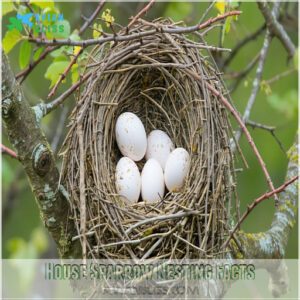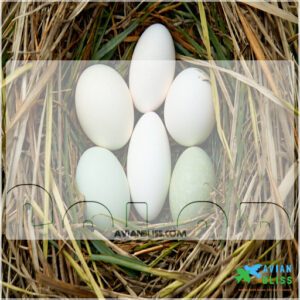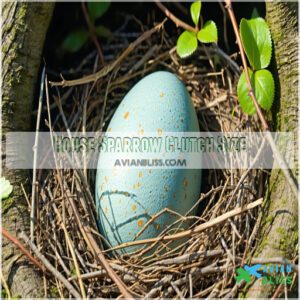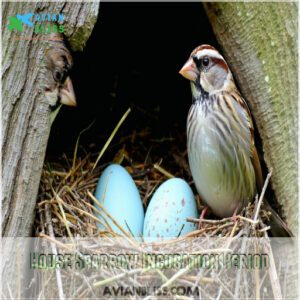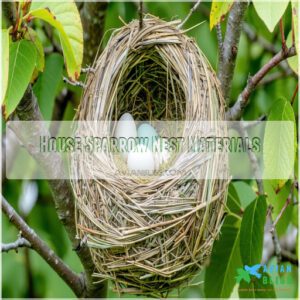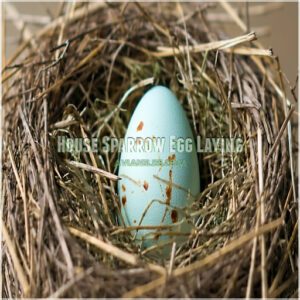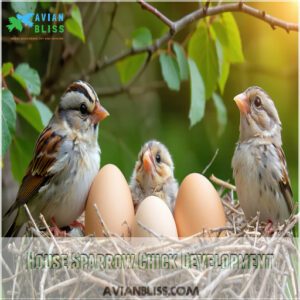This site is supported by our readers. We may earn a commission, at no cost to you, if you purchase through links.
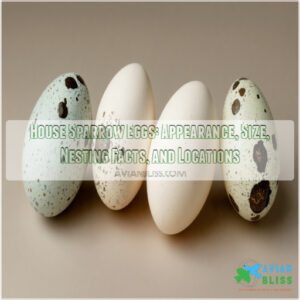
Their colors range from bluish-white to light brown, often adorned with gray or brown spots that vary from fine freckles to larger blotches.
These markings sometimes form delicate rings, giving each egg a unique, artistic charm.
A typical clutch contains 3-7 eggs, usually 4-6, laid one per day.
Both parents share incubation duties, which last 11-14 days.
The eggs’ compact size and intricate patterns reflect nature’s subtle artistry—proof that even the smallest details in life can hold remarkable beauty.
Curious about their nests?
Table Of Contents
- Key Takeaways
- House Sparrow Nesting Facts
- House Sparrow Egg Appearance
- House Sparrow Clutch Size
- House Sparrow Incubation Period
- House Sparrow Nest Locations
- House Sparrow Nest Materials
- House Sparrow Breeding Season
- House Sparrow Egg Laying
- House Sparrow Nest Building
- House Sparrow Chick Development
- Frequently Asked Questions (FAQs)
- What does a house sparrow egg look like?
- Do house sparrows lay eggs?
- How do you spot a house sparrow egg?
- Where do house sparrow eggs come from?
- How many eggs do sparrows lay?
- How do house sparrows incubate?
- Should I destroy house sparrow eggs?
- How long does it take for house sparrow eggs to hatch?
- How to identify house sparrow eggs?
- How long do baby house sparrows stay in the nest?
- Conclusion
Key Takeaways
- You’ll find house sparrow eggs to be small, glossy, and oval-shaped, measuring about 0.85 inches long, with colors ranging from bluish-white to light brown, often speckled with gray or brown spots.
- House sparrows lay 3-7 eggs per clutch, one per day, with both parents sharing incubation duties for 11-14 days to ensure the eggs hatch successfully.
- Their nests, built from twigs, feathers, and scraps, are messy but functional, adapting to urban spaces like roof crevices, streetlights, and tree cavities.
- Observing sparrow eggs reveals nature’s artistry, with intricate markings and compact designs that maximize survival in tight nesting spots.
House Sparrow Nesting Facts
Although house sparrows aren’t the pickiest nesters, they’re relentless in the matter of building a home.
Their nest architecture adapts to urban environments, whether it’s a crevice in your roof, a tree, or even a streetlight.
Sparrows use twigs, feathers, and random scraps to craft basketball-sized nests that look messy yet serve their purpose well.
With well-honed nesting habits, sparrows are dedicated parents, raising up to four broods a year.
Both parents share construction duties, ensuring breeding success.
Their noisy activity and knack for reclaiming spaces make their presence hard to miss!
House sparrows exhibit unique nesting behavior patterns that help them thrive in various environments.
House Sparrow Egg Appearance
When you examine house sparrow eggs, you’ll notice their sub-elliptical shape, glossy texture, and compact size.
Their coloration ranges from light brown to greenish or bluish-white, often adorned with gray or brown spots and wreathed markings that vary between clutches.
Color
Ever wondered what colour are sparrows eggs? These tiny wonders flaunt a range of eggshell hues, from creamy whites to soft greenish or bluish tones.
Their delicate nesting dyes often mirror subtle feather tones and plumage shades, blending perfectly with their surroundings.
House sparrows typically lay one egg per day, ultimately creating a clutch of one to eight eggs, according to this house sparrow nesting guide.
Over time, the sparrow egg color may shift slightly, adding to the charm of observing these natural masterpieces up close.
Markings
House sparrow eggs often steal the show with their intricate egg markings, each one a tiny masterpiece of nature.
These speckled patterns, like a painter’s brushstrokes, vary widely but usually cluster at the wider end of the shell.
- Egg patterns range from light freckles to dense spots.
- Brown and gray dots often form subtle rings.
- Some markings merge into larger blotches, adding character.
- The color of sparrow eggs enhances their unique charm.
- Each egg’s design reflects nature’s unpredictability, making sparrow eggs’ appearance endlessly fascinating.
Size
How big are sparrow eggs?
Tiny yet mighty, house sparrow eggs measure just 0.82 inches long and 0.6 inches wide—perfect for their snug nesting spots.
Their small size maximizes clutch volume, fitting up to eight eggs in tight spaces.
This compact design supports efficient chick growth in nest capacities like wall cavities or eaves.
| Trait | Measurement | Purpose | Adaptation |
|---|---|---|---|
| Length | 0.82 inches | Fits small nests | Urban nesting spots |
| Width | 0.6 inches | Allows multiple broods | High clutch volume |
| Weight | ~2.9 grams | Easy for parents to manage | Frequent egg-laying |
| Shape | Oval | Streamlined for space | Compact chick growth |
House Sparrow Clutch Size
Spotting a nest full of house sparrow eggs is like finding nature’s little surprises.
The house sparrow clutch size typically ranges from 3 to 7 eggs, with an average of 4-6.
These small, oval treasures arrive one at a time, laid daily, keeping the female energized and ready for her brood.
Here’s what makes their nesting strategy stand out:
- Clutch Variation: Egg numbers depend on factors like location, age, and density.
- Brood Success: Sparrows often raise multiple broods per season, boosting fledging rates.
- Nesting Outcomes: Larger clutches can mean higher survival odds for chicks.
This methodical approach guarantees their adaptability and success across diverse environments.
Understanding the house sparrow behavior is vital for grasping their nesting habits and remarkable ability to thrive in various settings.
House Sparrow Incubation Period
Once the clutch is complete, the sparrow egg incubation process begins.
Over the 11–14 day incubation period for sparrow eggs, both parents work tirelessly to maintain the right incubation temperature and nest humidity, ensuring brood survival. The female typically takes the lead, but the male assists when needed.
Here’s how they make it work:
- Eggs are carefully turned to distribute warmth evenly.
- Soft materials like feathers and grass insulate the nest.
- Warmer weather may shorten the incubation time.
This teamwork is essential for sparrow eggs incubation success. By the end of this phase, the parents’ dedication sets the stage for healthy chicks and eventual fledging success.
House Sparrow Nest Locations
Savvy urban architects, sparrows expertly transform everyday spaces into cozy homes.
After their two-week incubation period, these adaptable birds seek secure spots near reliable food sources for their growing families.
Their nest site selection reveals remarkable flexibility in urban nesting habits.
- Gaps under roof tiles and eaves become prime real estate, offering protection from weather and predators
- Street lights and building ledges serve as modern-day cliff faces for these resourceful settlers
- Tree cavities and dense garden habitats provide natural alternatives to human structures
- Dryer vents and ventilation holes transform into snug apartments with built-in climate control
- Birdhouses in your garden might attract nesting pairs, though they can outcompete native species
You’ll find house sparrow nests tucked into nearly any protected nook around human dwellings, from bustling city centers to quiet suburban neighborhoods.
Installing Sparrow Nest Boxes can be an effective way to attract and support these birds in your area.
House Sparrow Nest Materials
Three essential layers make up a house sparrow’s masterful nest construction: a sturdy outer shell, an insulating middle section, and a cozy inner sanctuary.
During material gathering, you’ll observe these resourceful birds collecting dried grass stems and small twigs for the exterior framework, weaving them into a robust 8-12 inch spherical structure.
The middle layer incorporates softer materials like plant fibers and string, while the innermost chamber features the finest feather incorporation and delicate materials they can source.
Their material choices aren’t random – sparrows carefully select items that provide both structural integrity and comfort.
You might spot them repurposing paper, string, or even bits of fabric, showcasing their adaptability in nest material selection.
The use of nest building materials is vital for the overall structure and safety of the nest.
House Sparrow Breeding Season
Seasonal breeding patterns transform your backyard into a sparrow sanctuary, with peak activity spanning March through August.
You’ll witness fascinating house sparrow reproduction rituals as males establish territories in suburban areas, where nesting success rates typically soar due to abundant insects.
Watch for these telltale signs of sparrow breeding season:
- Males performing dawn chorus displays from strategic perches
- Territorial disputes featuring dramatic aerial chases
- Pairs inspecting potential nest sites together
- Regular feeding patterns supporting breeding activities
- Complex courtship behaviors including chest puffing and wing displays
Seasonal variations in breeding activity depend on geographic location , with fledging rates influenced by local climate conditions.
You’ll notice these adaptable birds can produce up to four successful broods when conditions align perfectly, showcasing their remarkable reproductive strategy.
House Sparrow Egg Laying
When female house sparrows begin their egg production rates, they demonstrate remarkable efficiency by laying one egg each morning until their clutch is complete.
You’ll typically find 3-7 speckled eggs in a single clutch, with each egg showcasing a whitish or pale blue base decorated with brown markings.
The laying patterns follow a consistent schedule during peak breeding season from May to September, with most eggs appearing before noon.
These resilient birds maintain impressive nesting success by producing up to 4 broods annually, carefully monitoring house sparrow egg temperature requirements through shared incubation duties.
Both parents take turns warming the eggs for 10-14 days, ensuring ideal egg viability and maximizing their potential for successful fledging rates.
Understanding house sparrow nests is vital for appreciating the complexity of their breeding habits and nesting behaviors.
House Sparrow Nest Building
You’ll find male house sparrows starting the nest construction process by gathering coarse materials like twigs and grasses to create an 8 x 12-inch dome or cup-shaped structure.
Once the basic framework is complete, you’ll notice females taking over to add the finishing touches with soft materials such as feathers, fur, and fine plant fibers for the inner lining.
Male Role
During breeding season, male sparrows showcase their parental dedication through distinctive house sparrow breeding behaviors.
These feathered architects initiate Mate Selection by choosing prime nesting spots 5-15 feet above ground, often in building cracks or tree hollows.
Their Territorial Defense and Male Courtship involve:
- Gathering twigs, straw, and coarse materials for the nest’s foundation
- Defending their chosen territory through aggressive displays and vocalizations
- Attracting potential mates by performing intricate wing-drooping displays and persistent calling
This strategic approach to Breeding Strategies guarantees successful pairing, with males remaining actively involved in nest construction throughout the season, demonstrating exemplary Fatherly Care from the start.
The use of Sparrow Nesting boxes can also support their breeding efforts by providing safe and suitable locations for their nests.
Female Role
While males gather materials, you’ll observe the female house sparrow taking command of nest construction, showcasing distinct female behavior and nesting habits.
Inside their chosen spot, she carefully arranges soft materials, demonstrating unique parenting style as she weaves feathers, grass stems, and found treasures like string or paper into a snug cup-shaped structure.
During the house sparrow egg laying phase, she follows a precise sparrow egg laying schedule, producing one egg daily.
The female house sparrow nest becomes her domain as she spends up to 14 days incubating sparrow eggs, taking brief breaks when her mate offers relief.
Once the chicks hatch, both parents share feeding duties for two weeks until their offspring leave the nest.
House Sparrow Chick Development
After crafting their nest, parent sparrows witness their chicks’ remarkable growth journey.
These tiny hatchling house sparrows start life naked and sightless, but nestling care drives rapid development.
You’ll notice feather development appearing by week two, with pin feathers erupting through pink skin.
Baby house sparrows gain strength quickly – their beak formation completes as they move from soft foods to seeds.
House sparrow nestlings reach the fledgling stage around day 15, mastering short flights.
By the time they’re sub-adults, they’ve developed adult plumage and joined local flocks.
Frequently Asked Questions (FAQs)
What does a house sparrow egg look like?
Did you know house sparrow eggs are just 5 mm long.
They’re oval, glossy, and range from light brown to bluish-white, often speckled with gray or brown markings—tiny masterpieces of nature’s design!
Do house sparrows lay eggs?
Yes, they do!
House sparrows lay 3-6 eggs per clutch, with a range of 1-
Eggs are oval, light brown to bluish-white, often speckled, and laid daily.
Multiple broods happen annually, ensuring survival.
How do you spot a house sparrow egg?
Look for small, glossy, oval eggs about 5 mm long and 5 mm wide, with light brown, bluish-white, or greenish tones.
They’re often speckled with gray or brown spots, blending beautifully into messy nests.
Where do house sparrow eggs come from?
It’s like nature’s assembly line.
House sparrow eggs come from females during their breeding season, typically March to August.
After courtship, females lay one egg daily, nestled in cozy, feather-lined nests.
How many eggs do sparrows lay?
Sparrows typically lay 3-6 eggs per clutch, though it can range from 1-
They lay one egg per day, and factors like location, age, and altitude can influence the clutch size.
How do house sparrows incubate?
It’s a delicate delicate dance—house sparrows incubate their eggs for around 11 days, heating them with their bodies.
Both parents share duties, creating a cozy, consistent warmth while fiercely guarding against predators and harsh weather, which is a key part of their cozy incubation process.
Should I destroy house sparrow eggs?
Destroying house sparrow eggs depends on your goals.
They’re invasive and outcompete native birds, so removal can help protect biodiversity.
Check local laws first, though—some areas regulate egg removal, even for non-native species, to ensure that the process does not harm the environment or violate local laws.
How long does it take for house sparrow eggs to hatch?
Think of a tiny clock ticking inside each egg—house sparrow eggs typically hatch after 11 days of incubation.
In colder regions, though, the process might stretch to 14 days, depending on the temperature.
How to identify house sparrow eggs?
You’ll spot house sparrow eggs by their oval shape, glossy texture, and light brown to bluish-white color with gray or brown speckles.
They’re small, about 5 mm long, and usually found in messy nests.
How long do baby house sparrows stay in the nest?
Baby house sparrows stick around the nest for 15-20 days after hatching.
During this time, they’re helpless, pink, and featherless, relying entirely on their parents for warmth, protection, and a steady diet of insects.
Conclusion
From their intricate markings to their compact size, house sparrow eggs showcase nature’s artistry, precision, and adaptability.
You’ve learned about their colors, clutch sizes, and incubation periods, as well as the shared roles of male and female sparrows in nest building and chick development.
These tiny eggs, often hidden in creative nest locations, symbolize resilience and survival.
By observing house sparrow eggs, you’re not just watching birds—you’re witnessing a delicate yet enduring cycle of life.
- https://avianreport.com/house-sparrow-nest-eggs/
- https://www.allaboutbirds.org/guide/House_Sparrow/lifehistory
- https://www.terminix.com/blog/home-garden/sparrows-nest-and-eggs/
- https://www.gettingmoreontheground.com/2023/03/06/invasive-species-spotlight-house-sparrow/
- https://www.bbcearth.com/news/how-humans-shaped-the-evolution-of-the-worlds-most-common-bird

